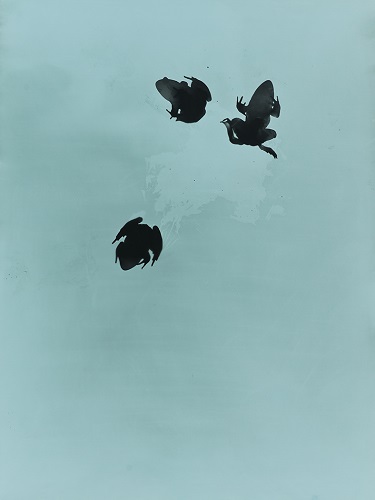
Kunie Sugiura
Japanese, 1942-
Hoppings I Positive 2, 1996
gelatin silver print
39 5/8 x 29 5/8 in.
SBMA, Museum purchase with funds provided by the Wallis Foundation
2003.70.2
COMMENTS
Kunie Sugiura’s artwork inhabits the space between light and shadow, body and spirit.
With photographic paper and chemicals, Sugiura (who pronounces her name kun-yay soo-gyoo-ra) freezes transient moments. Rather than use a camera, she lays flowers, fish, octopus or frogs directly on top of the paper, lets them make their own marks, and then exposes the whole thing to light. She then paints on toner and developer. What results is not a photograph, but a photogram, a physical record of what happened in the time that passed.
“Things were on that photographic paper. They actually touched it. It’s really actually there,” Sugiura said during an interview at the University of Maine Museum of Art, where her photograms are on view through Dec. 12. “At one time these things were present and now they’re not.”
Despite the fact that they document the passage of time through motion and chemical reaction, the photograms remain hauntingly simple. Sugiura, who was born in Nagoya, Japan, in 1942, came to the United States in 1963 to attend the Art Institute of Chicago. Though she has lived in the United States since then, her work has retained an Asian aesthetic that manifests itself in the form of natural inspiration and clean, organic lines.
“When I use nature as a subject matter, I feel very right – I feel comfortable,” Sugiura said. “I’m not political, I’m not an environmentalist, but I recognize that we as humans are part of a chain. I think traditionally, Asian people are more respectful, more worshipful of nature.”
Her flowers, either stacked in geometric patterns or suspended like kites from strings, look at once realistic and abstract. For “Boxing Papers,” friends donned boxing gloves dipped in chemicals, punched the paper, and then faked a fight in front of the paper. They look like shadows in motion, splashed with sweat or blood.
“They’re recognizable, but not too much so,” UMMA curator Wally Mason said. “She records a silhouette. … We don’t have a candle and an onion skin, but we basically have the same thing.”
These aren’t flat like your typical cutout silhouettes, however. Instead, the light may penetrate a translucent petal or get filtered out by a slosh of water, leaving a rich, three-dimensional effect.
“You have that dialogue back and forth about what you know about images in photography and what you don’t know about what light does when it sees something as flat,” Mason said. “People are going to come in here and think these are paintings, and in a sense, they’re right.”
For Sugiura, who uses traditional methods in her painting and drawing, photograms are a chance to “paint’ with light. The photogram, which has its roots in the 19th century work of William Henry Fox Talbot’s photogenic drawings, resurfaced in the 20th century with Dadaist Christian Schad’s “Schadograms” and Man Ray’s ghostly “Rayograms.”
Sugiura’s experimentation with photograms came when she tried to improve her drawing. She figured if she tried drawing in her darkroom, she wouldn’t be able to see very well, so she’d have to simplify her technique. But it strained her eyes, so she started to make compositions directly on photographic paper using things she had lying around, including a bunch of cut flowers.
“I tried to experiment with many things,” she said. “I recognized it. I liked the shape and I saw something very attractive about flowers.”
Since she started making photograms in 1980, she has added living, breathing subjects to her repertoire. In the tradition of avant-garde master Marcel Duchamp, the elements of chance and motion come into play in Sugiura’s work. Among the most intriguing pieces featured in this show is “The Kitten Papers,” which came about somewhat by accident. A friend had given her a pair of kittens and she couldn’t keep them in her apartment, so she brought them to her darkroom and left them there. When she returned the next morning, the kittens, who weren’t box-trained, had urinated on a piece of her photographic paper and left little footprints all over the place.
Rather than be disgusted, Sugiura was fascinated. She exposed the paper (and the kittens) to light, developed it, and liked the chemical reaction that took place.
“I thought, well, this is kind of interesting,” she said, so she repeated the process for nine days. The result is a set of seven photograms in which the kitten is almost an afterthought. The traces it left give the piece substance.
Unlike traditional photographs, the works on display are the actual pieces of paper that the kittens, flowers, frogs or fish touched. Though Sugiura can make up to five positive prints from each photogram negative, most of her pieces are unique. If she does something that appeals to her, she can replicate the process, yet each piece has subtle variations.
“They’re not allusions to something,” Mason said. “They’re the remnant of something.” ...
- Kristen Andresen, "Shadow boxer; Japanaese artist’s photograms capture silhouettes of motion", Bangor Daily News Maine Archive, Nov. 12, 2001
http://archive.bangordailynews.com/2001/11/12/shadow-boxer-japanaese-artists-photograms-capture-silhouettes-of-motion/
